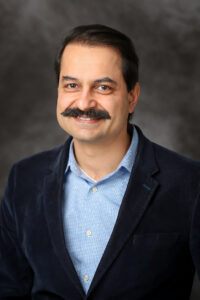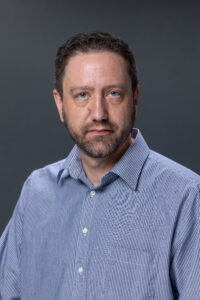For biomedical engineering students, internships start on Day One
Each day after class, students’ real-world problem solving with industry partners begins

“Learning:” The first core value of the UND LEADS strategic plan. The core value that exemplifies UND’s dedication, commitment and efforts to, among other things, “encourage a lifelong sense of wonder by providing educational experiences essential for living intellectually curious, personally fulfilling and socially responsible lives.”
There are several strategic objectives embedded within the Learning core value, and UND’s Biomedical Engineering program is creatively engaging with them – by standing the traditional model of “learning” on its head.
That means guiding students to work on solutions to real-life problems their first year in the program. They do this by interning for medical technology or device companies from the second floor of Columbia Hall, which houses the nerve center of the program, the Bioinnovation Zone or BiZ.
This hands-on approach is called innovation-based learning (IBL), and it encourages students to use their innate creativity to solve problems in the biomedical field.

This methodology, IBL, coincides perfectly with the Learning Strategic Objective of cultivating experiential learning opportunities with real-world applications derived from applied learning.
“Students take their classes in the BiZ, then walk out the door and go to work,” said Dan Ewert, program director for Biomedical Engineering. “It’s this new idea that you can seamlessly combine education and economic development. That’s really what this whole package is; that’s the big idea.”
Ewert is no stranger to this area. He spent 20 years teaching at North Dakota State University before heading to the University of Minnesota-Mankato in 2010, where he helped establish a successful engineering program that used project-based learning. It was part of Ewert’s efforts to transform the education model from “teach, assign homework, quiz and test,” to providing hands-on educational experiences to students.
It remains, Ewert said, a unique approach:
“Back in 2010, this was a hot thing. Nobody did this. It was crazy,” he said. “The idea behind it is that if you’re going to educate engineers, they should do engineering.”
So long, quizzes; hello, adding value
Ewert said education is handled differently in the BiZ. Students get the classroom education in the engineering principles they require, but then they put those principles into practice for actual medical device companies that have partnered with UND Biomedical Engineering.
Students do their internships just a few steps away from their classroom. They work remotely on projects through what are called internships-in-place. It’s the program’s goal to have an internship for every student who wants one, said Kouhyar Tavakolian, director of the BiZ. That makes the process a win-win for the company and the student, who has the opportunity to graduate debt-free.
Over the summer, Tavakolian spent time in countries such as Australia and Taiwan, talking up the program to medical device companies and sharing with them the chance to have critical work done by students.
In order to do that, cultivating creativity is key, Ewert said. He cited entities such as the World Economic Forum and Harvard Business Review (the latter has opined that the future of value creation lies in creativity), as inspirations to help put in place the IBL-based curriculum.
But how do you encourage student creativity? Creatively, it turns out. Gone are tests and quizzes, Ewert said. Employers don’t need or want someone who can “look up the answer at the back of the book.” Instead, they need people who can create value by harnessing creative energy to solve problems, and that means putting recently acquired skills into practice.
So, for example, “it can’t be ‘I’m going to give you a written report on what I did,” Ewert said. “You’ve got to go to conferences; you’ve got to present your work. And that means, even as freshmen.”
Solutions for industry
Ewert said that students studying in the BiZ have developed more than 30 “high-impact deliverables.”
Picture a student bioengineer applying problem-solving methods to biology and medicine. That might mean developing new wearable technology, creating a new medical device or improving an existing one. UND students have been leaders in these efforts.
Yitzi Devor is studying in the department online, from where he lives in New York. The second-year student is working on a device to improve the lives of people with hydrocephalus, a condition that causes a buildup of fluid in the skull, leading to intracranial pressure issues.
Devor spoke at a conference about his ideas, and his research team was awarded $50,000 to continue its work through the Center to Stream Healthcare In Place (C2SHIP), a research consortium that recently brought UND into its ranks. Participating in the consortium will give student biomedical engineers here more access to resources and opportunities than they could find regionally.
Also studying online is Bianka Valecruz. She is collaborating with the National Institutes of Health, where she collaborates with mechanical engineers and architects to revise, organize and archive drawings of the buildings at NIH campuses. She is also focusing on the standards and maintenance of research labs.
Valecruz took to heart the lessons she has learned in value creation and said she enjoys interdisciplinary work.
“I am drawn to biomedical engineering due to its expansive opportunities, driven by its rich interdisciplinary nature, allowing me to learn from each major engineering discipline and apply this knowledge to innovate solutions with the potential for significant real-world impact beyond the classroom,” she told UND Today.

Tavakolian has spent time teaching senior capstone projects in areas such as electrical engineering. He said he recognized the value of getting students to work on design right away, instead of waiting until their final year of university.
Seeing successes in their work, either through company recognition or grant funding, builds their confidence. “You can really thrive in this environment if you want to go out and make a difference in the world,” he said.
“There are no engineering students in Biomedical Engineering at UND. There are only student engineers.”
Locally, most people in the region are perfectly familiar with the moniker Red River Valley, for the region that encompasses the cities along the Red River of the North. The area is known for several things, including the University and its sports and academic programs, not to mention the rich agricultural land.
But Ewert said he hopes that as the Biomedical Engineering program grows at UND, our region will also come to be known as the “Medical Valley.”
UND’s student engineers already are working hard to put their biomedical engineering program on the map.
>> QUESTIONS OR COMMENTS about the UND LEADS Strategic Plan? Your thoughts are welcome! Please contact Angie Carpenter, UND’s director of Special Student Populations, and/or Ryan Zerr, professor and chair of Mathematics and associate vice president for Strategy & Implementation, the co-chairs of the UND LEADS Implementation Committee.
You also may offer your thoughts by visiting the UND LEADS Strategic Plan home page and clicking on the “Provide your feedback” link that you’ll find there.
Thank you for your support of the UND LEADS Strategic Plan!



